|
¡Deja eso!
Campaign against the parrot pet
trade
The parrot pet trade in the Dominican Republic is
contributing to their extinction in the wild.
Learn about this issue
(you
can click over the photos to view them larger and then hit the "back"
button to return to this page)
We have a very
special bird in the Dominican Republic: the parrot. It is an
endemic species (= only found in our island). This is why it`s
called the Hispaniolan parrot. Other islands in the Caribbean
have their own unique species. Ours is only found in the
beautiful island of Quisqueya, shared between the Dominican Republic
and Haiti.
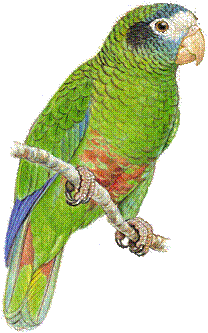 Wild parrots used to be relatively common until very recently. Our
parents and grandparents could easily see them flying over our
fields and forests. The crossed the skly in beautiful green
flocks, at the same time we could hear their noisy and cheerful
calls... Wild parrots used to be relatively common until very recently. Our
parents and grandparents could easily see them flying over our
fields and forests. The crossed the skly in beautiful green
flocks, at the same time we could hear their noisy and cheerful
calls...

Listen to the call of wild
parrots (download .wmv)
Taken
from: Bird songs from the Domnican Republic. Produced and published by
Cornell Univ. Ornithology Lab, Ithaca, NY, in cooperation with the
National History Museum of Santo Domingo
© 2002
But not anymore… This is because we have destroyed many of their
habitats, that is, their home, which is the forest...
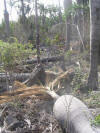
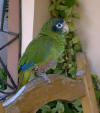
...And we have
captured them to have them as pets in our homes. Unfortunately,
many people find their ability to repeat words very amusing, and us
Dominicans LOVE to have captive parrots at home. Sometimes we
have them in cages or we cut their wing feathers to let them walk
around the house.
This however, is prohibited under Dominican law: The capture, trade and/or
possesion of parrots is banned by the Ley
General sobre Medio Ambiente y
Recursos Naturales No. 64-00. (General
Environment and Natural Resouces Law). But the law is rarely
enforced, and the parrot trade contitnues in the whole country.
Thus, every year, the majority of nests laid in the wild are poached
and the fledglings sold throughout the country.

This trade
harms them very much, because most of the stolen fledglings do not
survive. The majority die withing the first few days in
captivity or during transport to different towns. The
competition among parrot poachers is increasingly strong, each year
chicks are removed at earlier times, without even having grown their
feathers or opened their eyes. Its like taking away a newborn
baby from its mother.
•
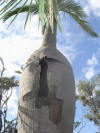 Another problem is that to remove the fledglings, the nest cavities (which
are reused from year to year) are destroyed. This reduces the
posibility of nesting for many parrots, since there are not too many
available cavities in their natural environment. Another problem is that to remove the fledglings, the nest cavities (which
are reused from year to year) are destroyed. This reduces the
posibility of nesting for many parrots, since there are not too many
available cavities in their natural environment.

By removing the
majority of fledglings produced in a given year, during many years,
the parrots are not able to maintain their populations, let alone
increase to previous levels. This is as if we killed every
baby born in a human population during many years.

By keeping a parrot in our home, we are depriving it of the possibilities
of reproduction during its lifetime. Even if we free it, this
parrot could not adapt again to the wild, because it didn't receive
parental care through which it would learn what to eat in the
forest, where to find food, and how to eat food (break open seeds,
etc).
If this pet trade continues, our parrots will dissapear in a few
years. If you truly love parrots and / our the environment of the
Dominican Republic, help us. Do not purchase parrots or accept
them as a present, you will be contributing to their extinction.
And
spread the word: help us explain everyone the great harm this pet trade
does to natural parrot populations.

©
Eladio Fernández 2007
Educational Materials
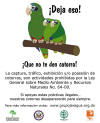
Download
the press ad (right click over the image). Help us by printing it,
sending over email, displaying it in visible places, etc.

Download
here the campaign logo (great for stickers and pins!)
Link
to Simón Guerrero`s article in Diario Libre 25 Sept 07
"Cotorra
de la Hispaniola al borde de la extinción"
Link to Simón Guerrero's article in Diario Libre 8 Oct 07
"Qué hacer y qué no hacer con las cotorras"
Link to Simón Guerrero's article in Diario Libre 24 de Junio 05 "Saquean
nidos de cotorras en el PN Bahoruco"
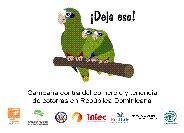
Download
a presentation (.ppt) on this issue based on this page
 Hispaniolan parrot fact sheet
(English) Hispaniolan parrot fact sheet
(English)
 Hispaniolan
parrot fact sheet (Spanish) Hispaniolan
parrot fact sheet (Spanish)
 Fact
sheet about this problem (Spanish) Fact
sheet about this problem (Spanish)
 Parrot
trail brochure (Cacos, Oviedo); Spanish only Parrot
trail brochure (Cacos, Oviedo); Spanish only
 Parrots
in danger: Large size for making flipchart presentation (Spanish). Parrots
in danger: Large size for making flipchart presentation (Spanish).
This campaign was made possible by:
|
 |
 |
 |
|
 |

|

Secretaría
de Estado
de Educación Superior,
Ciencia y Tecnología
FONDOCyT |
|
Crowder
Messersmith Conservation Fund / AUDUBON NATURALIST SOCIETY
|
|
